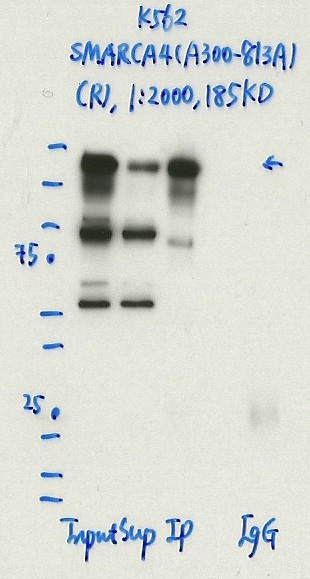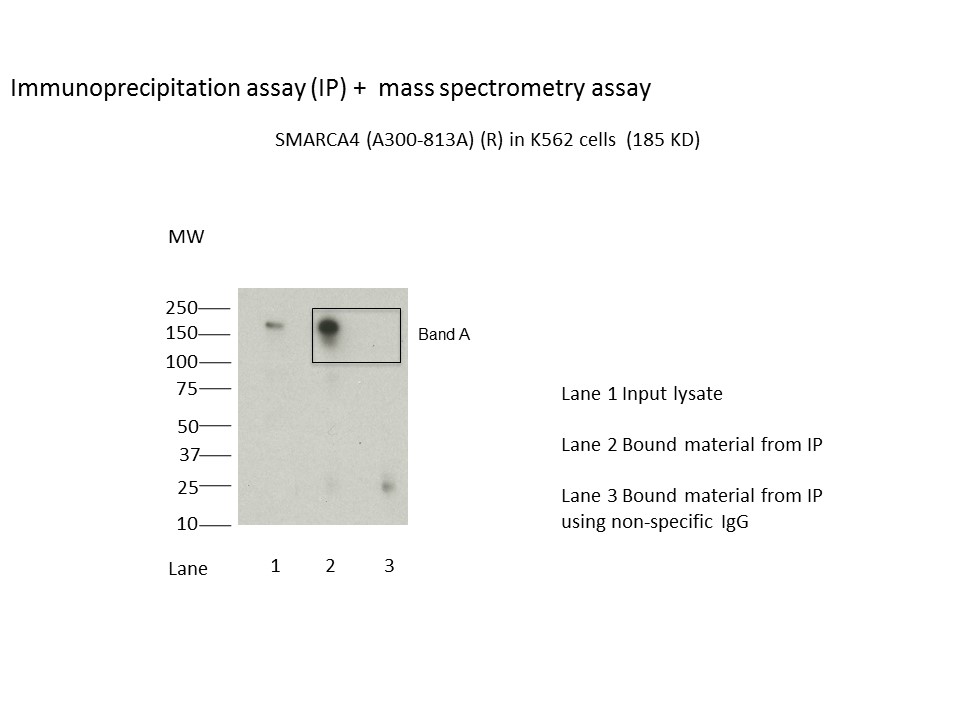ENCAB425IPH
Antibody against Homo sapiens SMARCA4
Homo sapiens
K562
characterized to standards with exemption
- Status
- released
- Source (vendor)
- Bethyl Labs
- Product ID
- A300-813A
- Lot ID
- 2
- Characterized targets
- SMARCA4 (Homo sapiens)
- Host
- rabbit
- Clonality
- polyclonal
- Purification
- affinity
- Aliases
- michael-snyder:AS-1281
- External resources
Characterizations
SMARCA4 (Homo sapiens)
K562
compliant
- Caption
- Immunoprecipitation was performed on nuclear extracts from the cell line: K562, using the antibody A300-813A. The blot shows western blot analysis of input, flowthrough, immunoprecipitate and mock immunoprecipitate using IgG.
- Submitted by
- Denis Salins
- Lab
- Michael Snyder, Stanford
- Grant
- U54HG006996
- Download
- 1047_09_SMARCA4_A300-813A.jpg
SMARCA4 (Homo sapiens)
K562
compliant
- Caption
- Immunoprecipitation was performed on nuclear extracts from the cell line K562 using the antibody A300-813A. Lane 1: input nuclear lysate. Lane 2: material immunoprecipitated with antibody. Lane 3: material immunoprecipitated using control IgG. Marked bands were excised from gel and subjected to analysis by mass spectrometry. Target molecular weight: 184.646.
- Submitted by
- Nathaniel Watson
- Lab
- Michael Snyder, Stanford
- Grant
- U54HG006996
- Download
- SMARCA4 (A300-813A)-1.jpg
SMARCA4 (Homo sapiens)
Method: immunoprecipitation followed by mass spectrometry
exempt from standards
- Caption
- IP followed by mass spectrometry. Briefly, protein was immunoprecipitated from K562 nuclear cell lysates using the antibody A300-813A, and the IP fraction was loaded on a 10% polyacrylamide gel (NuPAGEBis-Tris Gel) and separated with an Invitrogen NuPAGE electrophoresis system. The gel was stained by ColloidialCoomassie G-250 stain, gel fragments corresponding to the bands indicated were excised. Then proteins were trypsinized using the in-gel digestion method. Digested proteins were analyzed on an Orbitrap Elite mass spectrometer (Thermo Scientific) by the nanoLC-ESI-MS/MS technique. Peptides were identified by the SEQUEST algorithm and filtered with a high confidence threshold (Peptide false discovery rate < 1%, 2 unique peptides per protein minimum, mass error < 10 ppm).
- Submitter comment
- ARID1A, SMARCC1, ARID1B, SMARCC2 and SMARCA4 are components of BAF complex. http://www.genecards.org/cgi-bin/carddisp.pl?gene=SMARCA4&keywords=smarca4. ARID2 and PBRM1 have interaction with SMARCA4, http://thebiogrid.org/112481/summary/homo-sapiens/smarca4.html. ARID2 has interaction with SMARCA4, http://thebiogrid.org/112481/summary/homo-sapiens/smarca4.html. Both HNRNPUL1 (96KD) and SMARCA4 has interaction with BRD7(74KD), http://thebiogrid.org/112481/summary/homo-sapiens/smarca4.html and http://thebiogrid.org/116281/summary/homo-sapiens/hnrnpul1.html. But BRD7 is not in the gel slice with HNRNPUL1 and SMARCA4. Genecard: NONO and SFPQ form SFPQ-NONO complex, which is probably a heterotetramer of two 52 kDa (NONO) and two 100 kDa (SFPQ) subunits. http://www.genecards.org/cgi-bin/carddisp.pl?gene=NONO&keywords=nono. And NONO and SMARCA4 has interactions, 3 publications in http://thebiogrid.org/112481/summary/homo-sapiens/smarca4.html. NONO is not in the same gel slice with SFPQ and SMARCA4. ALB involves enzyme binding and chaperone binding. AZGP1 involves antigen binding and peptide antigen binding. PRPF8 is RNA-binding protein. BLMH is an enzyme.
- Reviewer comment
- SMARCA4 is not the top ranked TF but the submitters have noted that higher ranked TFs are part of the same BAF complex as SMARCA4.
- Submitted by
- Nathaniel Watson
- Lab
- Michael Snyder, Stanford
- Grant
- U54HG006996
- Download
- SMARCA4_A300-813A_final.pdf

